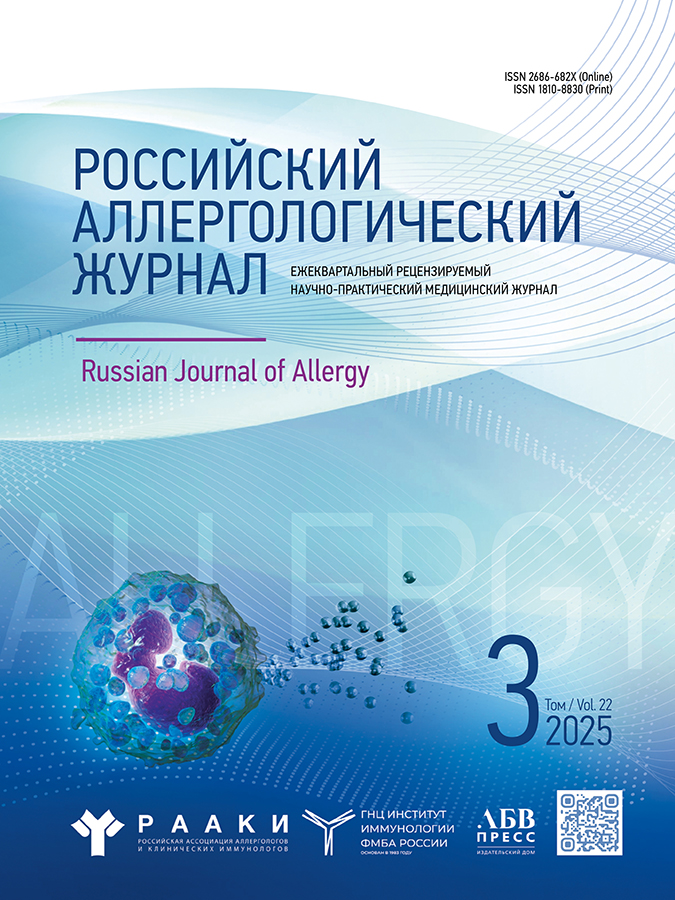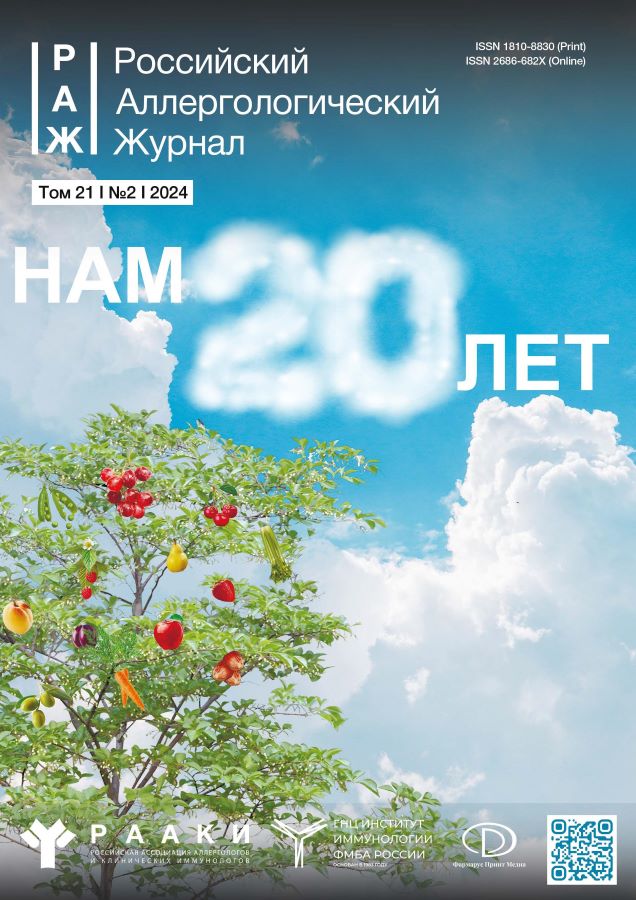Features of sensitization in patients with alopecia areata, associated with atopic diseases
- Authors: Potekaev N.N.1,2, Tereshchenko G.P.1,3, Pampura A.N.4, Gadzhigoroeva A.G.1, Zhukova O.V.1,3, Savastenko A.L.3
-
Affiliations:
- Moscow Scientific and Practical Center of Dermatovenereology and Cosmetology
- The Russian National Research Medical University named after N.I. Pirogov
- Peoples' Friendship University of Russia
- Veltischev Research and Clinical Institute for Pediatrics and Pediatric Surgery of the Pirogov Russian National Research Medical University of the Russian Ministry of Health
- Issue: Vol 21, No 2 (2024)
- Pages: 243-253
- Section: Original studies
- Submitted: 20.11.2023
- Accepted: 14.05.2024
- Published: 16.06.2024
- URL: https://rusalljournal.ru/raj/article/view/16904
- DOI: https://doi.org/10.36691/RJA16904
- ID: 16904
Cite item
Abstract
BACKGROUND: Association of alopecia areata and atopic diseases has been confirmed in clinical, epidemiologic, genetic and immunologic studies. The study of sensitization features and atopic diseases structure in alopecia areata patients makes it possible to phenotype patients with atopy and consider additional treatment options for alopecia areata.
AIM: To determine the sensitization spectrum and atopic diseases structure in alopecia areata patients considering the age and clinical form of alopecia.
MATERIALS AND METHODS: A comparative uncontrolled study was conducted. The data of 162 patients 5–51 years with alopecia areata, atopic dermatitis, asthma, allergic rhinitis/rhinoconjuctivitis for the period from April 2022 to May 2023 were used. The nature of sensitization and the structure of atopic diseases were analyzed. Clinical forms of alopecia areata were assessed by the hair-loss area.
RESULTS: The patients were divided according to alopecia areata status: the first group included 54 alopecia areata patients with atopic diseases, the second ― 108 atopic patients without alopecia areata. Subgroups were formed according to age: in group 1 the mean age was 16.3±1.38 years, 57% were children (5–17 years), 43% were older 18 years; in group 2 the mean age was 17.1±1.43 years, 54% children and 46% adults. Among alopecia areata patients seasonal pollen sensitization prevailed (22/54 people); polyvalent sensitization was observed in 13/54 people, 6 of whom had severe forms of alopecia areata, 6 ― ophiasis. Comparison of the sensitization spectrum between the groups revealed no differences. In group of adult alopecia areata patients isolated respiratory allergies were significantly less frequent (OR 0.21; CI 0.07–0.60; p=0.004), but combined atopic diseases were more frequently observed (OR 4.71; CI 1.43–15.58; p=0.012). Most patients with severe alopecia areata were children (8/12) with polyvalent sensitization and respiratory and combined atopic diseases.
CONCLUSION: The comorbidity of alopecia areata and atopy is manifested by an increased incidence of severe alopecia in childhood and a tendency to progression of allergic inflammation, realized as combined atopic diseases. The spectrum of sensitization in patients with and without alopecia areata does not differ and characterized by the predominance of the most common allergens (plant pollen). These results indicate the need for timely phenotyping of alopecia areata patients with allergic predisposition, especially with early onset and progressive alopecia.
Keywords
Full Text
About the authors
Nikolay N. Potekaev
Moscow Scientific and Practical Center of Dermatovenereology and Cosmetology; The Russian National Research Medical University named after N.I. Pirogov
Email: klinderma@mail.ru
ORCID iD: 0000-0002-9578-5490
SPIN-code: 8862-5688
MD, Dr. Sci. (Med.), Professor
Россия, Moscow; MoscowGalina P. Tereshchenko
Moscow Scientific and Practical Center of Dermatovenereology and Cosmetology; Peoples' Friendship University of Russia
Author for correspondence.
Email: gala_ter@mail.ru
ORCID iD: 0000-0001-9643-0440
SPIN-code: 1163-5456
MD, Cand. Sci. (Med.), Assistant Professor
Россия, Moscow; MoscowAlexander N. Pampura
Veltischev Research and Clinical Institute for Pediatrics and Pediatric Surgery of the Pirogov Russian National Research Medical University of the Russian Ministry of Health
Email: apampura@pedklin.ru
ORCID iD: 0000-0001-5039-8473
SPIN-code: 9722-7961
MD, Dr. Sci. (Med.), Professor
Россия, MoscowAida G. Gadzhigoroeva
Moscow Scientific and Practical Center of Dermatovenereology and Cosmetology
Email: aida2010@mail.ru
ORCID iD: 0000-0003-0489-0576
SPIN-code: 6021-0135
MD, Dr. Sci. (Med.)
Россия, MoscowOlga V. Zhukova
Moscow Scientific and Practical Center of Dermatovenereology and Cosmetology; Peoples' Friendship University of Russia
Email: klinderma@inbox.ru
ORCID iD: 0000-0001-5723-6573
SPIN-code: 8584-7564
MD, Dr. Sci. (Med.), Professor
Россия, Moscow; MoscowAlexey L. Savastenko
Peoples' Friendship University of Russia
Email: savasta@list.ru
ORCID iD: 0000-0002-8604-3612
SPIN-code: 5327-6190
Россия, Moscow
References
- Richardson CT, Hayden MS, Gilmore ES, Poligone B. Evaluation of the relationship between alopecia areata and viral antigen exposure. Am J Clin Dermatol. 2018;19(1):119–126. EDN: VKKXYD doi: 10.1007/s40257-017-0312-y
- Chu CH, Cheng YP, Chan JY. Alopecia areata after vaccination: Recurrence with rechallenge. Pediatr Dermatol. 2016;33(3):e218–e219. doi: 10.1111/pde.12849
- Petrova SYu, Albanova VI. Alopecia areata in atopic dermatitis: Coincidence or regularity? Russ Med Inquiry. 2022;6(2):85–91. EDN: UEDEFV doi: 10.32364/2587-6821-2022-6-2-85-91
- Kridin K, Renert-Yuval Y, Guttman-Yassky E, Cohen AD. Alopecia areata is associated with atopic diathesis: Results from a population-based study of 51,561 patients. J Allergy Clin Immunol Pract. 2020;8(4):1323–1328.e1. doi: 10.1016/j.jaip.2020.01.052
- Thomsen SF. Epidemiology and natural history of atopic diseases. Eur Clin Respir J. 2015;(2):24642. doi: 10.3402%2Fecrj.v2.24642
- Mohan GC, Silverberg JI. Association of vitiligo and alopecia areata with atopic dermatitis: A systematic review and meta-analysis. JAMA Dermatol. 2015;151(5):522–528 doi: 10.1001/jamadermatol.2014.3324
- Huang KP, Mullangi S, Guo Y, Qureshi AA. Autoimmune, atopic, and mental health comorbid conditions associated with alopecia areata in the United States. JAMA Dermatol. 2013;149(7):789–794. doi: 10.1001/jamadermatol.2013.3049
- Barahmani N, Schabath MB, Duvic M.; National Alopecia Areata Registry. History of atopy or autoimmunity increases risk of alopecia areata. J Am Acad Dermatol. 2009;61(4):581–591. doi: 10.1016/j.jaad.2009.04.031
- Ivert LU, Wahlgren CF, Lindelöf B, et al. Association between atopic dermatitis and autoimmune diseases: A population-based case-control study. Br J Dermatol. 2021;185(2):335–342. doi: 10.1111/bjd.19624
- Andersen YM, Egeberg A, Gislason GH, et al. Autoimmune diseases in adults with atopic dermatitis. J Am Acad Dermatol. 2017;76(2):274–280.e1. doi: 10.1016/j.jaad.2016.08.047
- Petukhova L, Duvic M, Hordinsky M, et al. Genome-wide association study in alopecia areata implicates both innate and adaptive immunity. Nature. 2010;466(7302):113–117. doi: 10.1038/nature09114
- Klasa B, Cichocka-Jarosz E. Atopic dermatitis: Current state of research on biological treatment. J Mother Child. 2020;24(1):53–66. doi: 10.34763/jmotherandchild.2020241.2003.0000010
- Czarnowicki T, He H, Krueger JG, Guttman-Yassky E. Atopic dermatitis endotypes and implications for targeted therapeutics. J Allergy Clin Immunol. 2019;143(1):1–11. doi: 10.1016/j.jaci.2018.10.032
- Ito T, Kageyama R, et al. Understanding the significance of cytokines and chemokines in the pathogenesis of alopecia areata. Experimental Dermatology. 2020;29(8):726–732. doi: 10.1111/exd.14129
- Suarez-Farinas M, Ungar B, Noda S, et al. Alopecia areata profiling shows Th1, Th2, and IL-23 cytokine activation without parallel Th17/Th22 skewing. J Allergy Clin Immunol. 2015;136(5):1277–1287. doi: 10.1016/j.jaci.2015.06.032
- Song T, Pavel AB, Wen HC, et al. An integrated model of alopecia areata biomarkers highlights both Th1 and Th2 upregulation. J Allergy Clin Immunol. 2018;142(5):1631–1634.е13. doi: 10.1016/j.jaci.2018.06.029
- El-Latif AR, Mohhamed GF, Attia F, et al. Immunoglobulin E and serum interleukin-4 in patients with alopecia areata and its correlation to the severity of the disease. J Turk Acad Dermatol. 2021;15(1):14–18 doi: 10.4274/jtad.galenos.2021.46220
- Kageyama R, Ito T, Hanai S, et al. Immunological properties of atopic dermatitis-associated alopecia areata. Int J Mol Sci. 2021;22(5):2618. doi: 10.3390/ijms22052618
- Ohyama M., Shimizu A., Tanaka K., Amagai M. Experimental evaluation of ebastine, a second-generation antihistamine, as a supportive medication for alopecia areata. J Dermatol Sci. 2010;58(2):154–157. doi: 10.1016/j.jdermsci.2010.03.009
- Yosipovitch G, Shi V. Dupilumab use in dermatologic conditions beyond atopic dermatitis: A systemic review. J Dermatol Treat. 2021;32(1):19–28. doi: 10.1080/09546634.2019.1689227
- McElwee KJ, Gilhar A, Tobin DJ, et al. What causes alopecia areata? Exp Dermatol. 2013;22(9):609–626. doi: 10.1111%2Fexd.12209
- Betz RC, Pforr J, Flaquer A, et al. Loss-of-function mutations in the filaggrin gene and alopecia areata: Strong risk factor for a severe course of disease in patients comorbid for atopic disease. J Invest Dermatol. 2007;127(11):2539–2543. doi: 10.1038/sj.jid.5700915
- Crosby DL, Gammon WR. Seasonal alopecia areata with atopy. J Am Acad Dermatol. 1989;21(4 Pt. 1):806–807. doi: 10.1016/s0190-9622(89)80279-8
- Putterman E, Castelo-Soccio L. Seasonal patterns in alopecia areata, totalis, and universalis. J Am Acad Dermatol. 2018;79(5):974–975. doi: 10.1016/j.jaad.2018.06.029
- Zhang X, McElwee KJ. Allergy promotes alopecia areata in a subset of patients. Experimental Dermatology. 2020;29(3):239–242. EDN: ATDFOE doi: 10.1111/exd.14027
- Gadzhigoroeva AG, Potekaev NN. Treatment of patients with nested alopecia taking into account the degree of activity of the process and the area of hair loss. Methodological recommendations [electronic resource]. Moscow; 2019. (In Russ). Available from: Lechenie-patsientov-s-gnezdnoj-alopetsiej.pdf. Accessed: 03.11.2023.
- Ministry of Health of the Russian Federation [electronic resource]. Clinical guidelines. Atopic dermatitis. 2021. (In Russ). Available from: https://cr.minzdrav.gov.ru/schema/265_2. Accessed: 03.11.2023.
- Barilo AA, Smirnova SV, Olyanina IM. Сlinical case of focal alopecia in a child with atopy. Med Immunol. 2021;23(1):191–196. EDN: ZLYZGX doi: 10.15789/1563-0625-CCO-2074
- Li SF, Zhang XT, Qi SL, et al. Allergy to dust mites may contribute to early onset and severity of alopecia areata. Clin Exp Dermatol. 2015;40(2):171–176. doi: 10.1111/ced.12471
- Levina JG, Kalugina VG, Namazova-Baranova LS, et al. Identification of pollen and food sensitization prevalence in children with different atopic phenotype variants (intermediate study results). Pediatric Pharmacology. 2022;19(5):394–403. EDN: KSVOBA doi: 10.15690/pf.v19i5.2464
- Nilova MYu, Tush EV, Eliseeva ТI, et al. Structure of sensitization to aeroallergenes in children with atopic bronchial asthma. Allergology Immunology Pediatrics. 2019; (2):17–23. EDN: UNKQIW doi: 10.24411/2500-1175-2019-00008
- Villasante Fricke AC, Miteva M. Epidemiology and burden of alopecia areata: A systematic review. Clin Cosmet Investig Dermatol. 2015;24(8):397–403. doi: 10.2147/ccid.s53985
- Lee HH, Gwillim E, Patel KR, et al. Epidemiology of alopecia areata, ophiasis, totalis, and universalis: A systematic review and meta-analysis. J Am Acad Dermatol. 2020;82(3):675–682. doi: 10.1016/j.jaad.2019.08.032
Supplementary files








